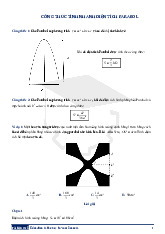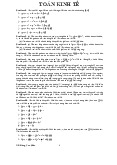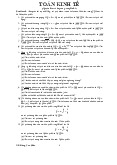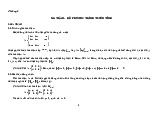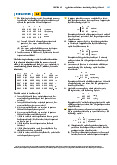

















Preview text:
Norm
Prove that ||.||_2 in R^2 is norm
R^2: ||u|| = sqrt(x^2 + y^2) với u = (x, y)
R^3: ||u|| = sqrt(x^2+y^2+z^2) với u =(x, y, z) (i) ||u||>= 0 and ||u|| = 0?
||u|| = sqrt(x^2 + y^2) >= 0
||u|| = 0 => sqrt(x^2 + y^2) = 0 X^2 +y^2 =0 X=0; y =0 u=(0,0) (ii) ||au|| = |a|.||u|| ||au|| = sqrt(a^2(x^2 + y^2))
=|a| sqrt(x^2 + y^2) = |a|.||u|| (iii) ||x+y|| <= ||x|| + ||y||
||u1 + u2|| <=||u1|| + ||u2|| ||u1|| = sqrt(x1^2 + y1^2) ||u2|| = sqrt(x2^2 + y2^2)
||u1 + u2|| = sqrt((x1+x2)^2 +(y1 + y2)^2)
Prove that ||u1 + u2|| <= ||u1|| + ||u2||
sqrt((x1+x2)^2 +(y1 + y2)^2) <= sqrt(x1^2 + y1^2) + sqrt(x2^2 + y2^2)
(x1 + x2)^2 + (y1 + y2)^2 <= x1^2 + y1^2 + x2^2 +
y2^2 + 2 sqrt((x1^2+y1^2)(x2^2 + y2^2)) (x1y2 – x2y1)^2 >=0 Thus the conclusion following
2. E, F: normed space. T is linear ||x||_1 = ||x||_E + 2||Tx||_F Is ||.||_1 is a norm on E (i) ||x||_1 = 0 ||x||_E = 0 x = 0 ||x||_1 >= 0 ||x||_E + 2||Tx||_F >=0 (ii)
||ax||_1 = ||ax||_E + 2||aTx||_F = |a|.||x||_E + 2|a|.||Tx||_F
=|a|.(||x||_E + 2||Tx||_F) = |a|.||x||_1 (iii)
||x+y||_1 <= ||x||_1 + ||y||_1
||x+y||_1 = ||x + y||_E + 2||T(x+y)||_F ||x||_1 = ||x||_E + 2||Tx||_F ||y||_1 = ||y||_E + 2||Ty||_F
||T(x+y)||_F = ||T(x)||_F + ||T(y)||_F
||x+y||_1 = ||x + y||_E + 2||T(x+y)||_F <= ||x||_E + 2||Tx||_F
+ ||y||_E + 2||Ty||_F = ||x||_1 + ||y||_1
Let X = R^3 be the vector space of all ordered pairs x =
(x1, x2, x3), y = (y1, y2, y3),… of real numbers. We
define ||x|| = |x_1| + |x_2| + |x_3| for any x in X. Prove that (X,||.||) is a normed space (i)
We have: |x_1| + |x_2| + |x_3| >= 0 ||x|| >= 0
||x|| = 0 => |x_1| + |x_2| + |x_3|=0 x_1 = x_2 = x_3 = 0 (ii)
||ax|| =|ax_1| + |ax_2| + |ax_3|
=|a|.|x_1| + |a|.|x_2| + |a|.|x_3|
= |a|.(|x_1| + |x_2| + |x_3|) = |a|.||x|| (iii) ||x+y|| <= ||x|| + ||y|| We have:
||x+y|| = |x_1 + y_1| + |x_2 + y_2| + |x_3 + y_3| ||x|| = |x_1| + |x_2| + |x_3| ||y|| = |y_1| + |y_2| + |y_3| |x + y| <= |x| + |y|
||x+y|| = |x_1 + y_1| + |x_2 + y_2| + |x_3 + y_3|
<= |x_1| + |y_1| + |x_2| + |y_2|+ |x_3| + |y_3| <= |x| +|y|
Let (X, ||.||) be a normed space. Prove | ||x|| - ||y|| | <= ||x-y|| for any x, y in X For any x, y in X
We have: | ||x|| - ||y|| | = ||x|| - ||y|| or ||y|| - ||x||
||x|| - ||y|| <= ||x – y|| ( triangle inequality)
||y|| - ||x|| <= ||y – x|| = ||x – y||
So, | ||x|| - ||y|| | <= ||x-y||
0 = ||a_1x_1 + a_2x_2|| <= ||a_1x_1|| + ||a_2x_2||
= |a_1|.||x_1|| + |a_2|.||x_2|| = |a_1| + 2|a_2| We have:
0 = ||a_1x_1 + a_2x_2|| >= | |a_1| - 2|a_2| |
|a_1| + 2|a_2| >= | |a_1| - 2|a_2| |
|a_1| + 2|a_2| >= |a_1| - 2|a_2|
or |a_1| + 2|a_2| >= -|a_1| + 2|a_2| 2|a_2| >= - 2|a_2| or |a_1| >= -|a_1| a_1 = 2 a_2 Linear F(x) = tp (2t.x(t)) dt F(ax+y) = tp(2t.(ax+y)(t))dt = tp(2t.a.(x)(t) +2ty(t))dt
= a.tp(2tx(t))dt + tp(2ty(t))dt = aF(x) + F(y) F(x) = tp((5-7t)x(t))dt
F(ax + y) = tp((5-7t)(ax + y)(t))dt
= tp((5-7t)ax(t) + (5-7t)y(t))dt
= a.tp((5-7t)x(t))dt + tp((5-7t)y(t))dt =aF(x) + F(y)
Let T: (R^2, ||.||_2) -> (R^2, ||.||_inf) be defined by T(x,y) = (x+3y, 2x+5y)
Show that T is a linear operator T(ax1 + x2, ay1 + y2)
= (ax1 + x2 + 3(ay1 + y2), 2(ax1 + x2) + 5(ay1 + y2))
= ((ax1 + 3ay1) + (x2 + 3y2), (2ax1 + 5ay1) + (2x2 +5y2)) (x+y, z+t) = (x, z) + (y,t)
= (ax1 + 3ay1, 2ax1 + 5ay1) + (x2 + 3y2, 2x2 +5y2)
= a(x1 + 3y1, 2x1 + 5y1) + (x2 + 3y2, 2x2 +5y2) = aT(x1, y1) + T(x2, y2) T is linear .Linear f(ax+y) = tp(2t (ax+y)t)dt = tp(2tax(t) + 2ty(t))dt
= a.tp(2tx(t))dt + tp(2ty(t))dt =a f(x) + f(y) .Bounded
|f(x)| = ||tp(0->1) ( 2tx(t))dt|| <= tp(0->1) ||2tx(t)||dt
<= tp(0->1) |2t|dt max|x(t)|
<= t^2 (0->1) . max|x(t)| <=1. Max|x(t)| = 1.||x(t)|| f is bounded by 1 .Linear
f(ax+y) = tp((5-7t)(ax+y)(t))dt
= tp(a(5-7t)x(t) + (5-7t)y(t)) dt
= a.tp((5-7t)x(t))dt + tp((5-7t)y(t))dt =af(x) + f(y) f(x) is linear .Bounded
|f(x)| = ||tp(0->1) (5-7t)x(t) dt||
<= tp(0 ->1) ||(5-7t)x(t)||dt
<= tp(0 ->1) |5-7t|dt . max|x(t)|
<= (5t -7/2 t^2)(0->1) .max|x(t)|
<= 3/2 .max|x(t)| = 3/2||x(t)|| f(x) is bounded by 3/2 f(x) = a1x1 + a2x2 + a3x3 .Linear f(ax+y) = = + =a + =af(x) + f(y) f is linear .Bounded
|f(x)| = || = |a1x1 + a2x2 + a3x3| <= ||a||.||x|| f is bounded by a
Let T: (R^2, ||.||_2) -> (R^2, ||.||_inf) be defined by T(x,y) = (x+3y, 2x+5y)
Show that T is a bounded linear operator .Linear T(ax1 + x2, ay1 + y2)
= (ax1 + x2 + 3(ay1 + y2), 2(ax1 + x2) + 5(ay1 + y2))
= ((ax1 + 3ay1) + (x2 + 3y2), (2ax1 + 5ay1) + (2x2 +5y2)) (x+y, z+t) = (x, z) + (y,t)
= (ax1 + 3ay1, 2ax1 + 5ay1) + (x2 + 3y2, 2x2 +5y2)
= a(x1 + 3y1, 2x1 + 5y1) + (x2 + 3y2, 2x2 +5y2) = aT(x1, y1) + T(x2, y2) T is linear .Bounded
||T(x, y)||_inf = ||(x+3y, 2x+5y)||_inf =max{|x+3y|, |2x+5y|}
<= max{|x| + 3|y|, 2|x| + 5|y|} = 2|x| + 5|y|
<= 2 sqrt(x^2 + y^2) + 5 sqrt(x^2 + y^2)
<= 7 sqrt(x^2 + y^2) = 7||(x,y)||_2 T is bounded
T: X -> Y be a bounded linear operator ||T|| != 0
For any x in X and ||x||_X < 1, we have: ||x||_X < 1 ||T||.||x||_X < ||T||
||T||.||x||_X > ||T(x)||_X < ||T|| ||T^(-1)(x)||_Y < ||T|| ||T(x)||_Y < ||T||
Let T: [0,1] -> R be the functional defined T(f) = f(0) for all f in C[0,1] a. Prove that T is linear
Choose f(x) = ax+y, for all x,y in X and a in R
T(ax+y) = ax(0) + y(0) = a.0 + 0 = aT(x) +T(y) T is linear
b. If C[0,1] is equipped with the sup-norm
||f||_inf = sup |f(x)|, x in [0,1] (Chỉ chứng minh bounded )
|T(f)| = |f(0)| <= C||f|| = C.sup|f(x)| Choose C =1 T is bounded by 1 T_b(f) = , f in G* . Linear T_b(af+y) = = + = a + = aT_b(f) + T_b(y) T_b(f) is linear . Bounded
Sup||T_b(f)|| = sup || < inf , b in B Since f(B) is bounded Exist c >0 such that
|| = ||T_b(f)|| <= c.||f||, for all f in G*, b in B
||b|| = sup <= sup c = c B is bounded
Assume that d is a metric on X and satisfies d(x+z, y+z) =
d(x,y) for all x, y, z in X. Then ||x|| = d(x,0) defines a
norm on X. Moreover, we have ||x-y|| = d(x,y) for every x,y in X . ||x||=d(x,0) >= 0 x >= 0
||x-y|| = d(x-y,0) = 0 => x=y
.||ax|| = d(ax, a0) = |a|.d(x,0) = |a|.||x||
. ||x+y|| = d(x+y, 0) = d(x+y-y, 0-y) = d(x, -y) <= d(x,0) + d(0,-y) <= d(x,0) + d(y, y-y) <= d(x,0) + d(y,0) <=||x|| + ||y|| ||x|| = d(x,0) is norm
||x-y|| = d(x-y,0) = d(x-y+y, y) = d(x,y) every x,y in x
Let ||.||_1 and ||.||_2 be norms on a vector space X. We
define ||x|| = max{||x||_1, ||x||_2} x in X. Prove that ||.|| is also a norm on X.
.||x|| = max{||x||_1, ||x||_2} >=0 ||x|| = 0 max{||x||_1, ||x||_2} = 0 ||x||_1 = 0 x = 0
.||ax|| = max{||ax||_1, ||ax||_2} = max{|a|.||x||_1, |a|.||x||_2}
= |a|. max{||x||_1, ||x||_2} = |a|.||x||
.||x+y|| = max{||x+y||_1, ||x+y||_2} Case 1:
||x+y|| = ||x+y||_1<=||x||_1 +||y||_1
<= max{||x||_1,||x||_2} + max{||y||_1,||y||_2}(1) Case 2:
||x+y|| = ||x+y||_2 <=||x||_2 +||y||_2
<= max{||x||_1,||x||_2} + max{||y||_1,||y||_2}(2) From (1) and (2): ||x+y||
<= max{||x||_1,||x||_2} + max{||y||_1,||y||_2} =||x||+||y||
||x|| = max{||x||_1, ||x||_2} is norm
